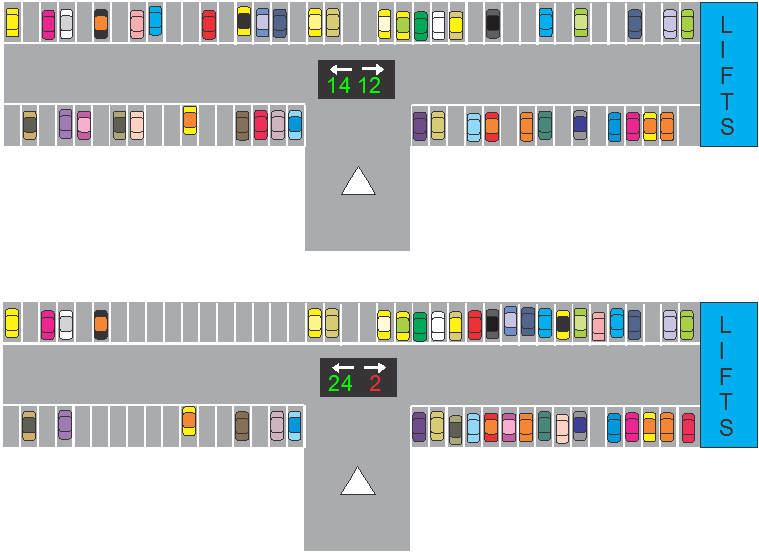![]() There are two main guidance methods that can be considered, guiding arrows or numeric displays
There are two main guidance methods that can be considered, guiding arrows or numeric displays

Numeric displays
1. Guiding Arrows
Guiding arrows have inherent logical problems due to the fact that they are a binary, YES/NO system.
Assume the following intersection with two cases:
- Case 1 - with 14 available spaces on the left and 12 available spaces on the right.
- Case 2 - with 30 available spaces on the left and 2 available space on the right.
Using guiding arrows each cases have two options:
- Option 1 – Point left, as there are more available parking bays on the left.
- Option 2 – Point left and right, as there are available parking bays on both sides.
1.1 Case 1.
Assume 14 available spaces on the left and 12 available spaces on the right.
Option 1 – Pointing left only because more parking is available to the left.

This option will compromise the main functionality of the system, i.e. guidance, as follows:
- There are parking bays available on the right so why directed to the left? Frequent users of the parking lot know where they want to park, as it may be close to their final destination. If it happens that the preferred space of a specific user is on the right, we will be compromising their convenience by forcing them to the left. Further, when they walk to their destination, which is on the right, they may realize that the system guided them against their preferred destination.
- As it is usually the case, people tend to park close to the elevators, escalator or stairs. The moment the first car is parked closer to the lift the balance will be towards the areas away from the lifts, again compromising on the user convenience.
Option 2 – Pointing both directions because parking is available on both sides.

Recommending going either way will work well in this case, however it is like the Cheshire cat from Alice In Wonderland. When Alice asked him for directions to the Mad Hatter he points to every possible direction with his four paws, two eyes and tail – i.e. confusion!
1.2 Case 2
With 24 spaces available on the left and 2 available spaces on the right.
Option 1 – Pointing left only because more parking is available to the left.

This option should be OK but, again, it compromises the main functionality of the system, i.e. guidance:
- Frequent users of the parking lot know where they want to park, as it may be close to their final destination. If it happens that the preferred space of a specific user is on the right, we will be compromising their convenience by guiding them to the left. Further, when they walk to their destination, which is on the right, they may realize that the system guided them against their preferred destination.
- As it is usually the case, people tend to park close to the elevators, escalator or stairs. The moment the first car is parked closer to the lift the balance will be towards the areas away from the lifts, again compromising on the user convenience.
Option 2 – Pointing both directions because parking is available on both sides.

This option may work but is likely to cause frustration.
- If there are only one or two spaces in the aisle there is a possibility a car already ventured into the aisle and in fact there is no parking at all.
- The one or two available parking spaces may need a bit of a search.
1.3 Guiding Arrows- Conclusion
From the above-described scenarios, we can derive two conclusions:
- Setting up the logic of the arrows and the thresholds there after, is not trivial and may differ from site to site and in the same site from hour to hour.
- Once the logic is decided and the thresholds are set, the main function of the system, guidance, will always be compromised.
2 Numeric Displays
2.1 Both cases and both options
The following drawing illustrates both cases. As can be seen both options are inherently looked after.

Numeric displays provide accurate information to the drivers. This information enables the driver themselves to make an intelligent decision based on:
- Availability of parking.
- Destination preference.
In other words, numeric display creates a Parking Guidance System i.e. accurate way finding.
The use of numeric displays offer s singular logic across sites levels and time of day.
Generally, numeric displays are more expensive and require extra commissioning effort. However the JVES Parking Guidance system was designed with the assumption that numeric displays will be the preferred guiding method. We therefore built into the system, applications that will enable us to control dozens of numeric displays without any commissioning effort.
2.2 Numeric Displays conclusion
We at JVES recommend way finding using numeric displays.
While numeric displays are somewhat more expensive and harder to implement, they do offer a simple and straightforward guidance.

